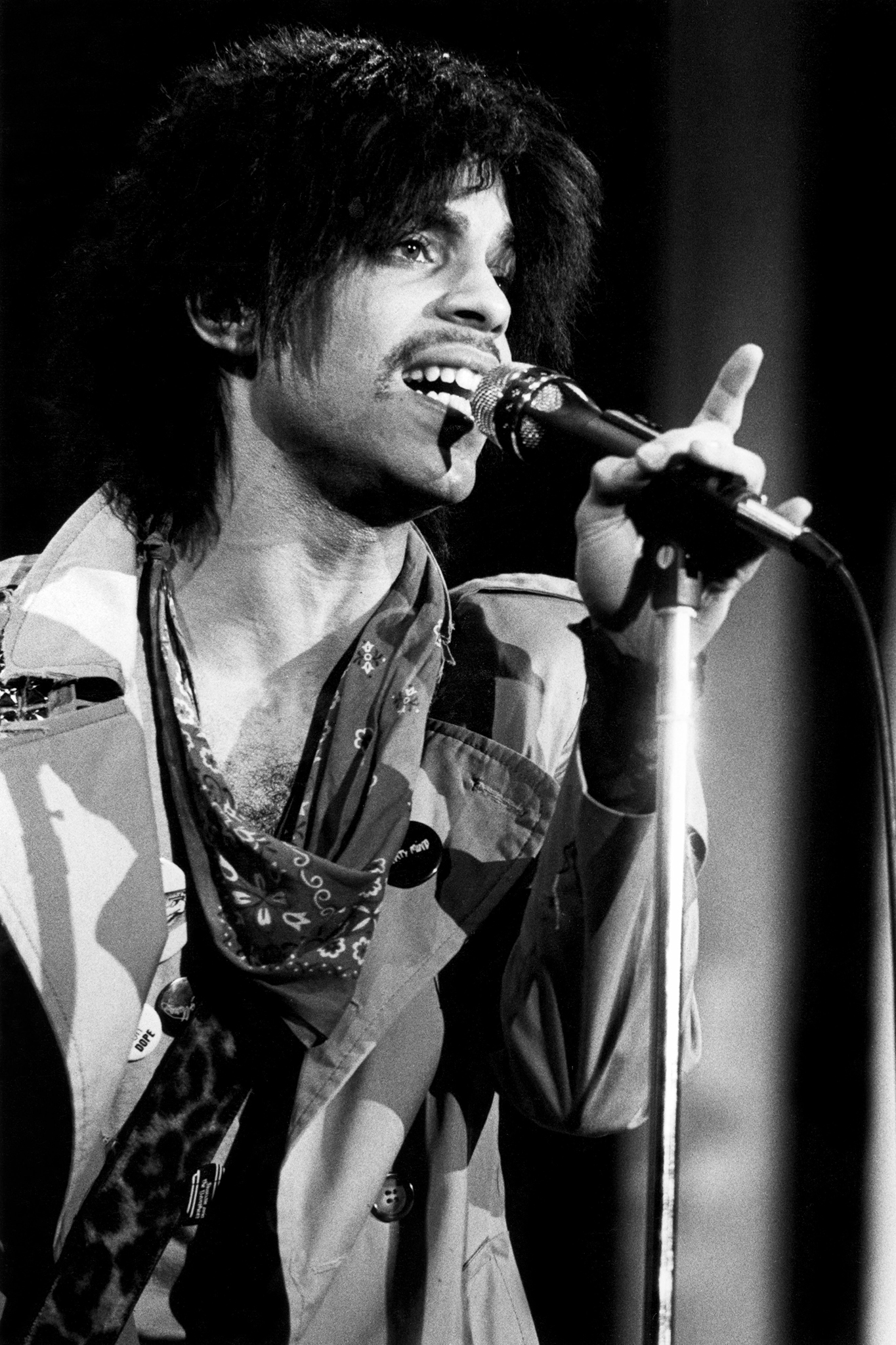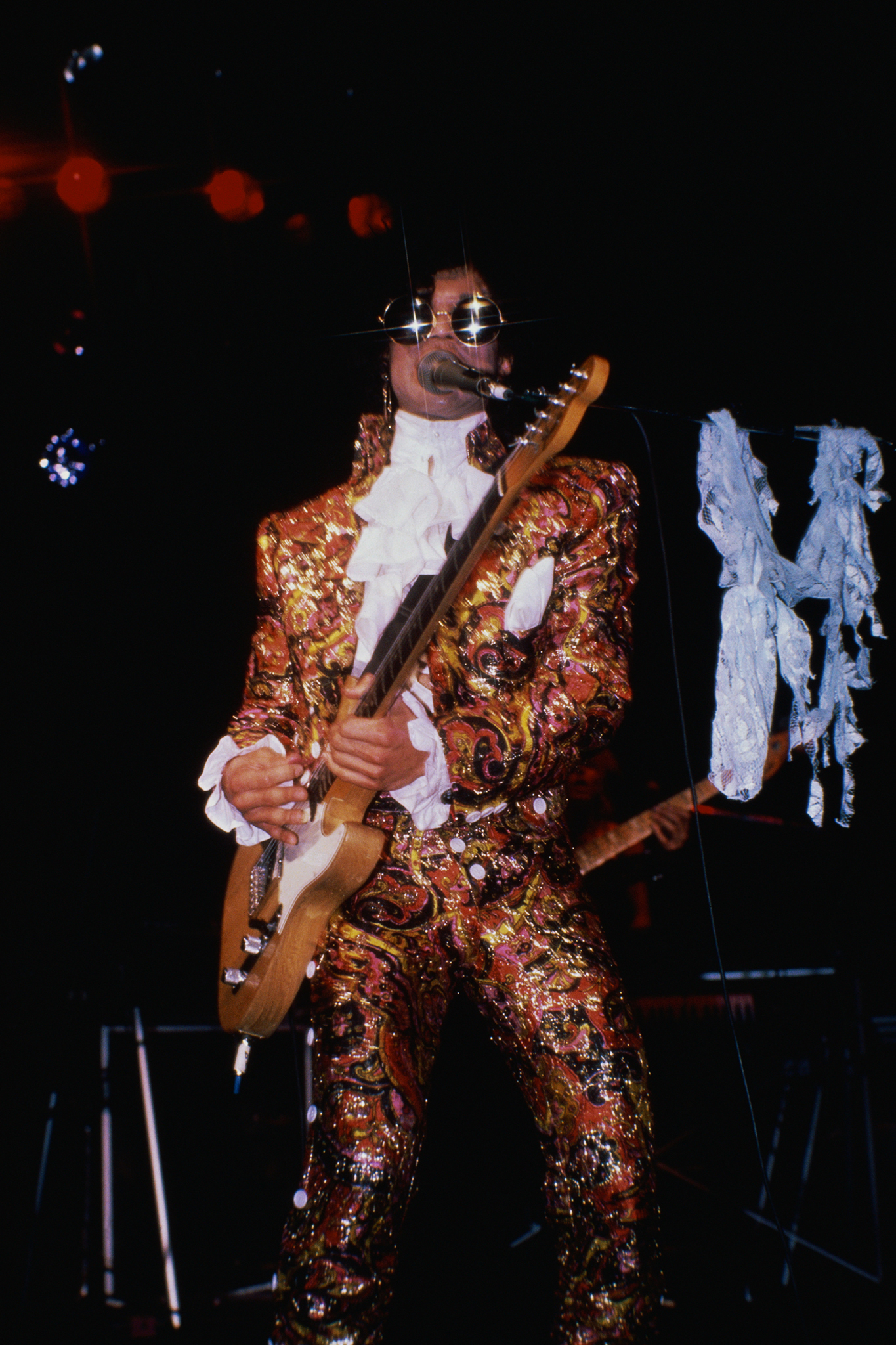Join or Sign In
Sign in to customize your TV listings
By joining TV Guide, you agree to our Terms of Use and acknowledge the data practices in our Privacy Policy.

Prince at the Ritz, March 1981
Music legend Prince died April 21, 2016, at 57 at his home, Paisley Park, in Minnesota. This gallery is a look back, in photographs, of the life and career of one of the most talented, iconic and enigmatic pop stars of all time.
In 1981, Prince was in the midst of his ascent to superstardom. His third and fourth albums, 1980's Dirty Mind and 1981's Controversy, solidified his reputation as one of the world's foremost creators of dirty, sexy baby-making music, though Controversy explored a nascent social consciousness as well. But it would be his next album, 1982's 1999, that would break him out in a big way.

Prince performing, 1984
1984 was the biggest year of Prince's career. His movie, Purple Rain, and its accompanying soundtrack conquered the world, with hits like "Purple Rain," "When Doves Cry," and "Let's Go Crazy" entering the canon of "songs everyone in the world knows." The album Purple Rain has sold 22 million copies worldwide.
Prince in concert, November 1984
1984 was the year he began crediting his backing band as the Revolution. The band included his Purple Rain co-stars Wendy and Lisa, and his longtime keyboardist "Doctor" Matt Fink. The Revolution was the first of his backing bands, and were replaced by the New Power Generation in 1990.
Prince performs in Oakland, Calif., 1985
In 1985, Prince released Around the World in a Day, which was released with minimal promotion and no advance singles, setting the template that would later be followed by Prince devotees like Radiohead and Beyoncé. It was one of the purest examples of Prince doing something completely unexpected. The album includes one of his best-loved songs, "Raspberry Beret."
Prince performing at American Music Awards, 1985
At the 1985 American Music Awards, Prince led all contenders with eight nominations and won three awards.
Prince performing at Grammy Awards, February 1985
Prince won two Grammys for Purple Rain: Best Rock Performance by a Duo or Group with Vocal and Best Score Soundtrack, and was nominated for Album of the Year, losing to Lionel Richie's Can't Slow Down.
Prince performing in Detroit for his birthday, June 1985
Prince turned 27 in 1985. By that point, he had won an Oscar and three Grammys, charted two No. 1 hits, had four platinum albums, and aided in the conception of an uncountable number of babies.
Prince performing, 1986
Prince released his second movie, Under the Cherry Moon, in 1986. It wasn't successful, but the accompanying soundtrack album, Parade, was a hit critically and commercially. That album's most enduring song, "Kiss," continues to pack dance floors every time it's played.
Prince and the Revolution performing, May 1986
The Parade tour was Prince's last with the Revolution. After the tour, he dissolved the band and went back to work finishing his first official solo album, which was to be a triple-album called Crystal Ball. His label, Warner Bros., forced him to cut it down to a double-album, which became Sign o' the Times, his most musically diverse and ambitious album, which contained songs like "Strange Relationship" and "I Could Never Take the Place of Your Man."
Prince in concert, August 1986
Crystal Ball was just one of a huge number of unreleased Prince projects. Sign o' the Times evolved out of Crystal Ball, which in turn had evolved out of Dream Factory, an album recorded with the Revolution and shelved, and Camille, which was going to be the debut album by Prince's female alter ego.
Prince performing in Paris, August 1986
Camille is one of the most interesting unrealized Prince projects. It was going to be credited to Camille, not Prince, and promoted as a separate entity. Camille's voice was Prince's pitched up to sound more feminine. Camille material made it to Sign o' the Times as "If I Was Your Girlfriend" and "Housequake."
Prince in Paris, June 1990
In 1989, Prince had his biggest commercial success since Purple Rain with his soundtrack to Tim Burton's Batman. While not considered one of his best works, it has sold over 11 million copies worldwide, and broke a sales slump he'd been in since Parade. Contractual complexities around the album contributed to Prince's eventual nasty falling out with Warner Bros. In 1990, he released his final movie, Graffiti Bridge, and its accompanying soundtrack saw the first appearance by the New Power Generation.
Prince at the World Music Awards ceremony in Monaco, May 1994
1993 was the year when Prince officially changed his stage name to the unpronounceable glyph that came to be called "Love Symbol #2." The symbol was a combination of the symbols for male and female. When he adopted the new name, Warner Bros. sent floppy disks containing a custom font to print publications to enable them to use the symbol. He would also be referred to as "The Artist Formerly Known as Prince."
Prince in London, March 1995
During this time, Prince began releasing albums at a rapid pace to satisfy his contract with Warner Bros., which he felt was trying to stifle his artistic vision. His albums during this period, including Come, The Gold Experience and Chaos and Disorder, were among his lowest-selling to date.
Prince performing, July 1996
He began appearing in public with the word "slave" written on his face, since he felt enslaved by his contract with Warner Bros. He released two albums on Warner Bros. in 1996, Chaos and Disorder and Girl 6, the soundtrack to a Spike Lee joint. His first post-Warner Bros. album, the three-disc, three-hour Emancipation, was released that November, making 1996 a prolific year even for him.
Prince performing in New York, 1997
Prince was one of the first musicians to embrace the Internet, though his relationship to it was complicated. He sold his 1998 album Crystal Ball directly to fans on his website. In 2001, he launched a website called NPG Music Club. Subscribers were given three new NPG songs per month, as well as other content and priority access to concerts and parties. It was an unprecedented at the time for the Internet to be embraced by a major artist. However, Prince refused to make his music available on streaming services like Spotify (since artists barely make money from it) and diligently removed any audio or video posted online without his consent.
Prince at Madison Square Garden, September 1998
Prince was romantically involved with many famous women, including Kim Basinger, Carmen Electra and Susanna Hoffs of the Bangles -- the latter two of whom he wrote songs for, including the Bangles' "Manic Monday" -- as well as his musical proteges like Vanity, Sheila E. and Apollonia. In 1996, he married his backup singer and dancer Mayte Garcia. They had a son, Boy Gregory, in October 1996. Boy Gregory was born with a rare genetic disorder called Pfeiffer syndrome and died when he was 1 week old. Prince and Garcia divorced in 1999. He was married to Manuela Testolini, whom he met when she worked for his charitable foundation, from 2001 to 2006.
Prince at the Coachella Music Festival, 2008
He retook the Prince name when his publishing contract with Warner Bros. expired in 2000, and launched into another period of productivity, releasing seven albums between 2001 and 2004. One of his 2004 albums, Musicology, was his most commercially and critically successful since Diamonds and Pearls in 1991. While never again meeting his mid-'80s peak in popularity, Prince remained one of the greatest live performers in the world. He headlined the Super Bowl halftime show in 2007, a performance widely considered the greatest Super Bowl performance of all time.
Prince at Fashion Week, October 2009
Prince became a Jehovah's Witness in 2001 and reportedly went door-to-door to proselytize his faith. He stopped using profanity in his songs, but he still performed overtly sexual music. Throughout his career, Prince explored all facets of human sexuality from many different angles, from gender performance to spirituality. Even his songs about social issues, like "Sign o' the Times," had a romantic and/or mystical bent.
Prince at Skanderborg Festival, August 2013
Prince leaves behind a legacy as one of the most talented performers who ever lived. He could play almost any instrument, sing and play and dance in high heels for three hours straight, and write songs that alternately made people dance and cry. He remained completely unpredictable, relentlessly independent and totally unique. There will never be another person like Prince, and his death is an enormous loss. He was so far ahead of his time that the world may never catch up.